Final report for GNC15-211
Project Information
New nest boxes installed in Michigan cherry orchards since 2012 have been used extensively by kestrels. We used nest box video cameras to determine that kestrels provision their nestlings with known orchard pests, including grasshoppers, voles, and fruit-eating birds; furthermore, we observed generalizable trends in kestrel prey removal based on nestling age, seasonal timing of prey availability, brood size and sex ratio, weather, and adult female movements relative to the nest box. We used transect surveys to determine that fruit-eating bird counts were lower in orchards with active kestrel nest boxes, thus kestrel activity associated with nest boxes likely acts as a reliable cue of predation risk that, in combination with direct consumption, reduces fruit-eating bird abundances in orchards. Finally, we previously used live-trapping to determine that summer small mammal abundances were lower in orchards with active kestrel boxes and orchards that had been more recently mowed; however, these differences did not carry over as differences in winter presence in orchards, when mammal damage to trees is most likely. We therefore present recommendations for future work on small mammal abundances in orchards.
This project resulted in the installation of 25 nest boxes in cherry orchards throughout Leelanau County, MI and prompted an expansion of our nest box program into the blueberry-growing region of southwestern MI. Presentations at MSU Extension workshops and farmer expos reached dozens of cherry and blueberry growers in MI, and press releases about this project have the potential to reach growers nationwide. Ongoing research, funded by a National Science Foundation Dynamics of Coupled Natural and Human Systems Grant, will use a national survey of fruit growers and in-person interviews, along with modeling approaches, to investigate factors that influence grower adoption of predator nest boxes as a pest management practice.
Objective 1) Effects of kestrel nest boxes and supplemental perches on kestrel presence and fruit-eating bird abundances in orchards:
Objective 2) Effects of kestrel nest boxes and supplemental perches on winter rodent abundances in orchards:
Objective 3) Estimating number of prey removed and extent of prey removal by kestrels breeding in orchard nest boxes:
Cooperators
Research
Objective 1) Effects of kestrel nest boxes and supplemental perches on kestrel presence and fruit-eating bird abundances in orchards:
We completed surveys of fruit-eating bird abundances in orchards with and without active kestrel boxes and perches during the summers of 2015 and 2016. In 2015, we conducted surveys at 30 sites in 15 orchards: five orchards with an active kestrel box, five orchards with an active kestrel box and perches, and five orchards with no kestrel box within 1.6 km. At orchards with active kestrel boxes, we placed sites within 150 m of the box. At orchards with perches, we placed sites within 100 m of a perch. In orchards with sweet and cherry blocks, we placed one site in a block of each crop type; in orchards with blocks of one crop type only, we placed one site at the orchard edge and one in the interior (at least six rows in from the edge row). We placed the two sites in each orchard at least 150 m apart to reduce the chance of observing the same individuals at both sites during a survey visit. In 2016, we conducted surveys at 14 sites in 14 orchards: three orchards with an active kestrel box, four orchards with an active kestrel box and perches, and seven orchards with no kestrel box within 1.6 km or perches. We placed all sites in sweet cherry blocks in 2016. We conducted 10 minute surveys along 200 m-long fixed-width transects. We conducted a total of 268 surveys over both years.
Perch Use
We also analyzed video recordings of artificial perches in order to assess kestrel perch use. We randomly chose five orchards with active kestrel nest boxes in 2015 in which to install artificial perches. We built the perches from 6.4 m of steel pipe mounted on 1.2 m of rebar buried 0.9 m underground, resulting in a 5.5 m perch height. The perches themselves were 45 cm lengths of 2.54 cm-wide pine dowel attached to the pipe with a floor flange. We installed three perches per orchard; we placed perches within the orchard rows, usually in an open spot where a tree was missing. In 2015, we recorded each perch during daylight hours (06:00 – 21:00 EST) once per week.
Objective 2) Effects of kestrel nest boxes and supplemental perches on winter rodent abundances in orchards:
During the winter of 2015 - 2016, we surveyed rodents in orchards using camera traps. Camera trap stations consisted of a modified Hunt trap, designed to prevent disturbance by larger non-target animals, containing a weatherproof security camera connected to a portable video recording system (see description of camera recording setups for Objective 3 below). We conducted surveys between November 2015 and March 2016 at nine orchard sites with blocks of trees that were 3 years old or younger: three orchards with active kestrel boxes during the summer, three orchards with active boxes and supplemental perches, and three orchards with no active box within 1.63 km and no supplemental perches. We conducted surveys in one or two blocks per orchard. In orchards with more than two young blocks, we conducted surveys in two randomly chosen blocks. We set up three camera trapping stations in each block: one in a randomly chosen spot in an interior tree row, and two in randomly chosen edge rows that have continuous edge habitat. Each camera trap station served as a trapping site. We left the camera traps at each site for 24 h. We conducted one to three surveys per site.
Objective 3) Estimating number of prey removed and extent of prey removal by kestrels breeding in orchard nest boxes:
Recording Prey Deliveries to Kestrel Nests
Prior to the start of the 2013 and 2014 breeding seasons, we installed a weatherproof security camera with night vision ($27 each; Bunker Hill Security) inside each of the boxes. During the 2014 season, we began moving the cameras and attaching them to the overhang of the nest box roof in cases where nestling feces had obscured the lens. Prior to the 2015 season, we had moved most cameras outside of the boxes. We found that camera location did not affect kestrel nest success or productivity. We recorded prey deliveries to a box using a video recording system consisting of a mini digital video recorder (DVR, $80; SecurityMan, Ontario, California, U.S.A.) with an 8 – 32 GB SD card (≥ $4), 300 W DC-to-AC power inverter ($25; Bestek), and a 12-V rechargeable sealed lead acid deep cycle battery (≥ $60), all housed in a polyethylene plastic storage tote. In 2013, we used two UB12120 12 Ah batteries run in parallel in each recording setup; in 2014 – 2016, we used a 24MDC marine battery with 75 Ah capacity in each setup.
Our recording system used lower cost components than similar systems and allowed us to easily rotate a setup among multiple nest boxes. We deployed a recording setup at a nest box prior to the start of the target recording day. We synchronized time and date for the DVR at each deployment. A recording day lasted from 09:00 – 17:00 EST in 2013, from either 07:00 – 19:00 or 06:00 – 21:00 in 2014, and from 06:00 – 21:00 in 2015 and 2016. We recorded each nest box at least twice per season during the four week nestling period; we recorded a box once per week when possible. In 2013, we programmed the DVRs to record continuously during recording day hours. In order to reduce file size and review time in 2014 – 2016, we programmed the DVRs to record using motion capture. We set the motion target window around the box entrance so that prey deliveries would trigger the recording. We also included at 2 s pre-record that captured the kestrel as it approached the box entrance.
We reviewed video files in QuickTime Player 7. We recorded the time of each prey delivery and the sex of the kestrel making the delivery (if one kestrel passed a prey item to the other at the box, then we recorded the sex of the first kestrel). We classified each delivery as one of the following prey types: arthropod, mammal, bird, herptile, annelid, mollusc, unidentifiable invertebrate, or unidentifiable vertebrate.
Recording Kestrel Movements Using GPS Data Loggers
We used a protocol successfully tested in 2015 to deploy GPS data loggers on adult female kestrels in 2016. We trapped kestrels in the nest boxes within the first 10 d post nest hatching by blocking the box entrance with a sponge on an extendable pole; if the kestrel flushed before we could place the sponge, we would temporarily install a remote controlled trap door in the box. We collected standard measurements, including weight, for each kestrel and fitted her with a USGS metal leg band. We fitted kestrels weighing at least 130 g with a 3.0 g GiPSy-5 GPS data logger (TechnoSmArt, Italy), weatherproofed with 0.5 g of either self-sealing tape or a mixture of baking soda and cyanoacrylate glue, attached to a 1 g Teflon ribbon diagonal-loop backpack-style harness, so that the weight did not exceed 3.5% of the bird’s weight. We attached the harness straps to the data logger using rivets made from 80 lb test monofilament. After releasing the kestrel, we observed her until she flew out of sight to confirm that she was moving normally. Finally, we recaptured the kestrel three days later to remove the GPS data logger and download the data.
We programmed the GPS data loggers with a 9 – 12 hr delay and treated the first day of deployment as an acclimatization period. We then programmed the data loggers to record a locational fix every 30 s or 1 min between 06:00 – 21:00 EST. We screened the data to first remove fixes with a Position Dilution of Precision (PDOP) >1.5 in order to remove grossly imprecise locations. We then removed fixes with timestamps corresponding to periods when the kestrel was inside the nest box, as determined from the nest box video recordings. Finally, we calculated the distance between each remaining locational fix and the nest box.
Objective 1) Effects of kestrel nest boxes and supplemental perches on kestrel presence and fruit-eating bird abundances in orchards:
We built mixed effects models of fruit-eating bird counts and found that counts were significantly lower at sites with an active kestrel box (Figure 2). We did not find a significant effect of perches.
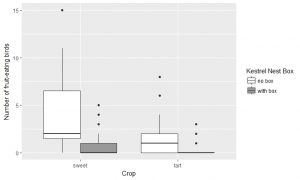
fixed-width survey areas at sweet and tart orchard blocks with and without active nest boxes. Boxplot whiskers extend 1.5 IQRs.
Perch Use
Kestrel use of the perches was significantly greater in orchard blocks with shorter trees (Figure 2). Kestrels mostly used the perches installed in the youngest orchard blocks; meanwhile, we conducted the fruit-eating bird surveys in mature orchard blocks where kestrels rarely used the perches.
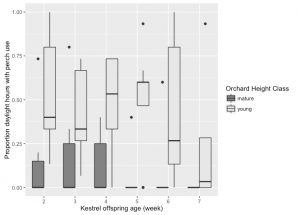
So although the perches in mature orchard blocks did not further reduce fruit-eating bird abundances, perches in young blocks could still provide benefits to the kestrels, particularly for fledglings as they leave the nest box (Figure 3).
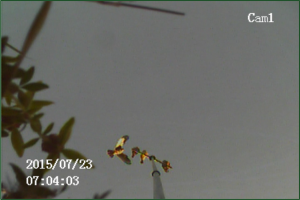
Figure 3. Fledgling kestrels using artificial perch in orchard.
Objective 2) Effects of kestrel nest boxes and supplemental perches on winter rodent abundances in orchards:
We detected small mammals at 17 of the 51 trapping sites and during 19 of 135 surveys across all trapping sites during the three trapping rounds. We detected no voles during the winter 2015 – 2016 surveys; we identified all detections as Peromyscus spp. (Figure 4).
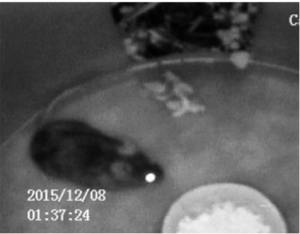
Figure 4. Peromyscus spp. detected at camera trap in orchard.
We recorded small mammal presence or absence during 15 min intervals (events) within each 24 h survey. We then built a dynamic occupancy model of Peromyscus spp. presence. Using this model, we found no effect of nest boxes or perches on Peromyscus spp. winter presence. However, we determined that Peromyscus spp. were more likely to colonize trapping sites in edge rows compared to interior rows. Furthermore, we were more likely to detect a mouse during an event at night and if we had detected a mouse during the preceding event. The estimated number of occupied sites decreased between the Nov and Mar survey rounds, which indicates a decrease in the Peromyscus spp. population over the winter.
We detected rodents during only 19 of 135 trapping opportunities, which suggests that either rodent presence in orchards was low (due perhaps to rodenticide use or lack of snow cover), or detections were low due to the camera trap setup.
Due to a lack of sustained snow cover in 2015 - 2016, we had planned to conduct more camera trap surveys during the winter of 2016 - 2017 in order to determine if rodent presence increased with snow cover, but we were unable to sufficiently explore this variable due to the repeated lack of sustained snow cover 2016 - 2017.
Objective 3) Estimating number of prey removed and extent of prey removal by kestrels breeding in orchard nest boxes:
Recording Prey Deliveries to Kestrel Nests
We analyzed video from 15 boxes across 179 recording days and documented 7,778 prey deliveries; overall, arthropods and mammals were the two most common prey types delivered (Figure 5). Crickets were the most common invertebrate delivered; voles were the most common vertebrate.
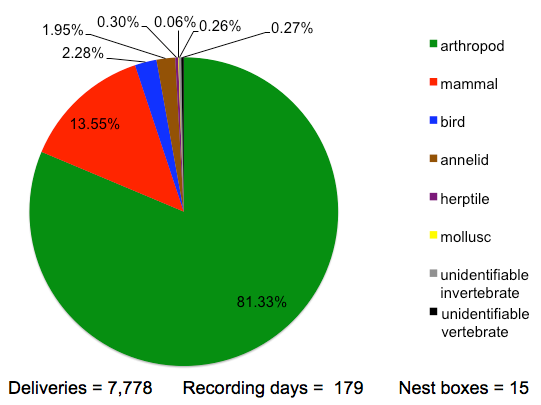
We used mixed effects modeling to determine the total number of prey deliveries to a nest in a day increased with nestling age at a decreasing rate over the nestling period. Deliveries decreased with increasing precipitation and increased with increasing temperature. Growing degree days (GDD) showed a concave relationship to total deliveries, with a peak in deliveries around 200-300 GDD, which corresponds to the adult emergence of early insects (Figure 6). Finally, the total number of deliveries decreased with higher proportions of female nestlings in a nest. Furthermore, the proportion of mammal deliveries decreased with nestling age at a decreasing rate over the nestling period. The proportion of mammal deliveries decreased with GDD and temperature, and increased with precipitation and wind speed. The proportion of mammal deliveries increased with higher proportions of female nestlings.
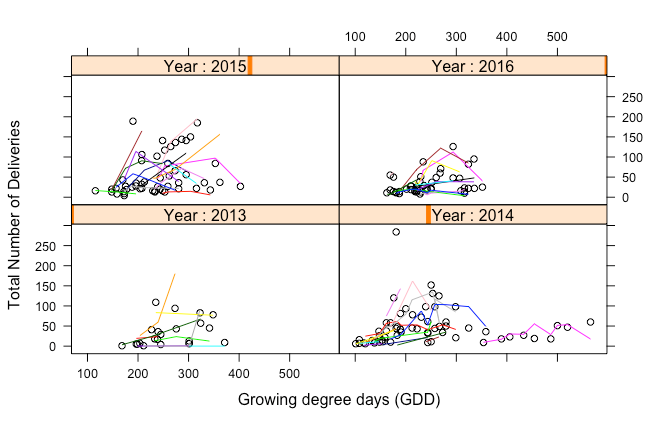
These results suggest some generalizable trends in prey removal by a kestrel pair over the breeding season. First, based on the observed relationships of prey deliveries to GDD, kestrels with nests that hatch just before or during the 200 – 300 GDD range should remove more total prey than the earliest- and latest-hatching nests, while kestrels with nests that hatch earliest in the growing season should remove higher daily proportions of mammals and may therefore remove more mammals over the entire season. Kestrels should remove more total prey during warmer summers with less precipitation; however, they may remove more mammal prey during colder summers with more wind and precipitation. Also, kestrels with nests that ultimately produce more fledglings should remove more total prey. Finally, kestrels with nests with higher proportions of female nestlings should remove fewer total prey but more mammals.
Recording Kestrel Movements Using GPS Data Loggers
We fitted 10 female kestrels with GPS data loggers during the 2016 season. We used mixed effects modeling to determine that the probability of a kestrel delivering a vertebrate prey item to the nest decreased with nestling age and increased with mean kestrel distance from the box. As predicted by the load size effect for central place foragers, female kestrels were more likely to deliver vertebrate prey as their mean distance from the nest box increased, because it is more energy efficient to carry heavier prey (vertebrates) over longer distances than lighter prey (invertebrates). Thus, female kestrels tended to capture invertebrate prey closer to the nest box and vertebrate prey further from the box (Figure 7).

Educational & Outreach Activities
Participation Summary:
PUBLICATIONS
Shave, M.E., S.A. Shwiff, J.L. Elser and C.A. Lindell. 2018. Falcons using orchard nest boxes reduce fruit-eating
bird abundances and provide economic benefits for a fruit-growing region. Journal of Applied Ecology. DOI: 10.1111/1365-2664.13172
Lindell, C.A., R.A. Eaton, P.H. Howard, S.M. Roels and M.E. Shave. 2018. Enhancing agricultural landscapes to
increase crop pest reduction by vertebrates. Agriculture, Ecosystems & Environment 257: 1-11.
Shave, M.E., B. Lundrigan and C.A. Lindell. In Press. Effects of American Kestrel nest boxes on small mammal
prey in cherry orchards. Proceedings of the 28th Vertebrate Pest Conference.
Shave, M.E. 2017. Evaluating the conservation and agricultural applications of orchard nest boxes for a declining raptor. Dissertation, Michigan State University, East Lansing, Michigan, USA.
PRESENTATIONS
Shave, M.E., B. Lundrigan and C.A. Lindell. Effects of American Kestrel nest boxes on small mammal prey in
cherry orchards. Vertebrate Pest Conference, Rohnert Park, CA. Feb 2018. (Talk)
Shave, M., S. Shwiff, J. Elser and C. Lindell. Nest boxes benefit a declining raptor and ecosystem services in a
fruit-growing region. American Ornithological Society Meeting, Michigan State University, East Lansing,
MI. August 2017. (Symposium talk)
Shave, M. and C. Lindell. Effects of American Kestrel nest boxes and perches on fruit-eating bird activity in cherry orchards. Tree Fruit IPM School, MSU AgBioResearch, Traverse City, MI. February 2017. (Invited talk)
Shave, M. and C. Lindell. Evaluating the agricultural and conservation applications of American Kestrel nest
boxes in a fruit-growing region. American Kestrel Symposium, American Kestrel Partnership, The
Peregrine Fund, Wilmington, DE. January 2017. (Invited talk)
Shave, M. and C. Lindell. Effects of American Kestrel nest boxes and perches on fruit-eating bird activity in cherry orchards. Great Lakes Fruit, Vegetable & Farm Market EXPO, Grand Rapids, MI. December 2016. (Talk)
Shave, M. and C. Lindell. Orchard nest boxes increase American Kestrel presence in a fruit-growing region of
Michigan. North American Ornithological Conference, Washington DC. August 2016. (Talk)
Lindell, C. and M. Shave. Risk factors and management strategies for bird damage in fruit. North American
Raspberry and Blackberry Association Meeting, Williamsburg, VA. March 2016. (Contributions to talk)
Lindell, C., M. Shave, P. Howard, A. Anderson, and S. Shwiff. Birds in orchards: economic, biological, and social
aspects of ecosystem services. Ecological Society of America 100thAnnual Meeting, Baltimore, MD.
August 2015. (Contributions to talk)
PRESS ARTICLES & OTHER MEDIA APPEARANCES
Dybas, C. and L. Cameron. "Lifting the Economy on Hawks' Wings." MSU Today. May 2018. <https://msutoday.msu.edu/news/2018/lifting-the-economy-on-hawks-wings/> (Online article)
McGlashen, A. "Protecting Crops with Predators Instead of Poisons." Environmental Health News. Mar 2018. <http://www.ehn.org/back-to-basics-tackling-farm-pests-with-predator-birds-2546940909.html> (Online article)
Dybas, C. and L. Cameron. “American kestrels, most common predatory birds in U.S., can reduce need for
pesticide use.” NSF Discovery. Mar 2018.
<https://www.nsf.gov/discoveries/disc_summ.jsp?cntn_id=244549 > (Online article)
“Saving the American Kestrel.” Ray Brown’s Talkin’ Birds. August 2017.
<http://www.talkinbirds.com/archive/2017/8/27/639-aug-27-2017> (Radio acknowledgement)
“Michigan bird conservation stories: Pigeons past to plovers present.” MSU Museum, Michigan State University.
July 2017. <http://museum.msu.edu/?q=node/464> (Museum exhibit)
Dau, J. “Feathered friends: How the American Kestrel and fruit growers are helping one another.” MSU
AgBioResearch FUTURES Magazine. July 2017. < http://www.canr.msu.edu/news/feathered-friends-howthe-american-kestrel-and-fruit-growers-are-helping-one-another>
(Online article)
“Partner Spotlight.” American Kestrel Partnership Quarterly. American Kestrel Partnership, The Peregrine Fund.
Fall 2016. <https://tinyurl.com/ycp4yenx> (Online interview)
Osowski, V. “MSU to study use of falcons to protect orchards.” MSU Today, Michigan State University. November
2015. <http://msutoday.msu.edu/news/2015/msu-is-looking-to-protect-orchards-with-falcons/> (Online
article)
Project Outcomes
Most notably, we found that fruit-eating bird counts were significantly lower at cherry orchards with active kestrel boxes. (Objective 1). Our results have been corroborated by observations shared by the cherry growers.
These results prompted us to use observations of fruit-eating birds to estimate sweet cherry loss in cherry orchards with and without kestrel boxes. Through a subsequent National Science Foundation Dynamics of Coupled Natural and Human Systems Grant, we worked with our economist collaborators to conduct a benefit–cost analysis of nest box installation and used regional economic modelling to estimate macroeconomic impacts of increased sweet cherry production in Michigan, an important US fruit production region. Benefit–cost ratios for kestrel nest boxes indicated that for every dollar spent on nest boxes, $84 to $357 of sweet cherries would be saved from fruit-eating birds. Regional economic modelling predicted that increased sweet cherry production from reduced bird damage would result in 46–50 jobs created and $2.2 million to $2.4 million in increased income for the state of Michigan over a 5-year period.
Ongoing work by our sociologist collaborators will use a national survey of fruit growers and in-person interviews, along with modeling approaches, to investigate factors that influence grower adoption of predator nest boxes as a pest management practice. By integrating information from ecology, economics, and food systems sociology, this project will improve understanding of linkages between natural predator-prey effects, the degree to which humans can manipulate such effects through providing resources to predators, and the potential for factors other than economic ones to influence grower decisions about agricultural practices.
Objective 1) Effects of kestrel nest boxes and supplemental perches on kestrel presence and fruit-eating bird abundances in orchards:
Objective 2) Effects of kestrel nest boxes and supplemental perches on winter rodent abundances in orchards:
Overall, our results prompt us to propose three recommendations for future research on the effects of raptor predation in orchards. First, we recommend utilizing a consistent surveying protocol across seasons if possible in order to facilitate seasonal comparisons and detect potential carry-over effects of predation by migratory predators. Next, we suggest conducting surveys in orchards without rodenticide use in order to detect effects of predation that were potentially masked in the present study by the reductions of small mammal populations following rodenticide application. Finally, we recommend combining small mammal surveys with fruit and tree damage assessments in order to identify which species are responsible for damage throughout the year and under different conditions (e.g., with variation in snowfall). In particular, more evidence is needed to determine the extent of orchard damage attributable to Peromyscus spp..
Objective 3) Estimating number of prey removed and extent of prey removal by kestrels breeding in orchard nest boxes:
Our results can be used to propose additional cases where prey removal by kestrels is potentially valuable for pest reduction. For example, in drought years when young fruit trees are especially susceptible to grasshopper damage, nest boxes in young orchard blocks would encourage predation of grasshoppers and other large herbivorous insects in that block by the female kestrel, for she will hunt for invertebrate prey close to the nest box. Furthermore, the lack of precipitation should increase the number of prey captured. In another case, a mild winter or peak in vole populations that results in high spring vole abundance may also result in kestrels producing female-biased broods and provisioning them with greater proportions of mammal prey. Thus, kestrels may dampen vole cycles and reduce peak vole abundances, as expected for generalist predators, which may help mitigate the risk of high vole damage during the following winter.